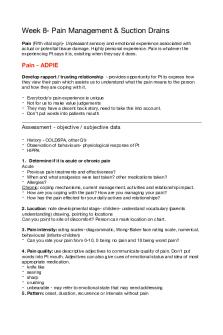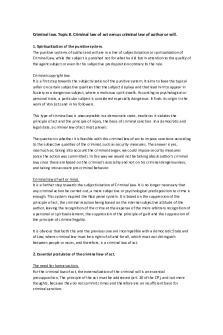LN8 IPSec - Lecture notes 8 PDF

| Title | LN8 IPSec - Lecture notes 8 |
|---|---|
| Author | Wong Kai Jeng |
| Course | Information And Network Security |
| Institution | Monash University |
| Pages | 38 |
| File Size | 1.6 MB |
| File Type | |
| Total Downloads | 35 |
| Total Views | 62 |
Summary
FIT3031 INFORMATION & NETWORK SECURITY infotech.monash FIT3031 INFORMATION & NETWORK SECURITY GCO2831/FIT3031 Lecture 8 IP Security infotech.monash Review of Last Lecture • • • • • • • • Security of email system is extremely important as this is the most widel...
Description
FIT3031 INFORMATION & NETWORK SECURITY
www.infotech.monash.edu
FIT3031 INFORMATION & NETWORK SECURITY GCO2831/FIT3031
Lecture 8 IP Security
www.infotech.monash.edu
Unit Objectives ✓ OSI security architecture common security standards and protocols for network security applications common information risks and requirements
✓ ✓ ✓ ✓ ✓ ✓ ✓ • • • •
operation of private key encryption techniques operation of public encryption techniques concepts and techniques for digital signatures, authentication and non-repudiation security threats of web servers, and their possible countermeasures Wireless Network Security Issues security threats of email systems and their possible countermeasures IP security intrusion detection techniques for security purpose risk of malicious software, virus and worm threats, and countermeasures firewall deployment and configuration to enhance protection of information assets network management protocol for security purpose
LN8: IP Security : FIT3031 Information & Network Security
3
Review of Last Lecture •
• • •
• • •
•
Security of email system is extremely important as this is the most widely used networkbased application – abuse of email (e.g., spreading of virus) is increasing – small change of financial data in email may bring disastrous consequences Four key requirements of email security are: > Confidentiality, authentication, message integrity and non-repudiation of origin Three main schemes that have emerged during past few years for email security are: PGP, S/MIME and DKIM PGP offers five services: Authentication, Confidentiality, Compression, E-mail compatibility and Segmentation PGP introduces the concept of key rings, key rings store key id, public keys, trust levels PGP is mainly for personal e-mail security, in future, S/MIME will probably emerge as the industry standard S/MIME secures MIME entity with encryption and digital signature with X509.v3 certificates DKIM: cryptographically signing email messages, domain claims responsibility, transparent to user LN8: IP Security : FIT3031 Information & Network Security
4
Lecture 8: Objectives • Be familiar with Internet Protocol Security (IPSec) capabilities • Understand IPSec Architecture • Understand Encapsulating Security Payload (ESP) • Be familiar with transport and tunnel modes of operation • Appreciate the concept of security association and combining SAs • Understand key management in IPSec LN8: IP Security : FIT3031 Information & Network Security
5
Lecture : Outline • • • • • • • •
IP Security Review of TCP/IP, IPv4 Introduction to IPSec Security Association (SA) Encapsulating Security Payload (ESP) IPSec Operation modes Combining Security Association IPSec Key Management LN8: IP Security : FIT3031 Information & Network Security
6
IP Security • have a range of application specific security mechanisms – eg. S/MIME, PGP, Kerberos, SSL/HTTPS
• however there are security concerns that cut across protocol layers • would like security implemented by the network for all applications
LN8: IP Security : FIT3031 Information & Network Security
7
Encapsulation ( 5 layer TCP/ IP model)
LN8: IP Security : FIT3031 Information & Network Security
8
Brief Preliminary: IPv4 header
• • • •
Header length = 20 octets (1 octet = 8 bits) Some fields may change on route, i.e., ‘Time to Live’, ‘Fragment Offset’ ‘Header Checksum’ is meant to protect header from corruption But hackers can purposely change header fields as well as checksum
LN8: IP Security : FIT3031 Information & Network Security
9
Brief Preliminary: TCP/IP Protocol • Internet Protocol is implemented at Network layer • End systems and all intermediate nodes (router, gateway etc.) implements IP • Packets are routed by IP • No built-in security feature in IP
LN8: IP Security : FIT3031 Information & Network Security
10
IPSec • IPSec is a set of protocols to provide high quality, interoperable, and cryptology-based security for IP packets • IPSec Provides – authentication – confidentiality – key management • applicable to use over LANs, across public & private WANs, & for the Internet
LN8: IP Security : FIT3031 Information & Network Security
11
Benefits of IPSec • When implemented in a firewall/router it provides strong security to all traffic crossing the perimeter • It is Implemented below application layer, hence transparent to applications • can be transparent to end users • can provide security for individual users • secures routing architecture
LN8: IP Security : FIT3031 Information & Network Security
12
IP Security Architecture • specification is quite complex, with groups: – Architecture > RFC4301 Security Architecture for Internet Protocol
– Authentication Header (AH) > RFC4302 IP Authentication Header
– Encapsulating Security Payload (ESP) > RFC4303 IP Encapsulating Security Payload (ESP)
– Internet Key Exchange (IKE) > RFC4306 Internet Key Exchange (IKEv2) Protocol
– Cryptographic algorithms – Other LN8: IP Security : FIT3031 Information & Network Security
13
IPSec Services 1. 2. 3. 4.
Access control Connectionless integrity Data origin authentication Rejection of replayed packets – a form of partial sequence integrity
5. Confidentiality (encryption)
LN8: IP Security : FIT3031 Information & Network Security
14
Security Associations (SA) • SA is a one-way relationship between sender & receiver that affords security for traffic flow • SA is defined by 3 parameters: 1. Security Parameters Index (SPI) 2. IP Destination Address 3. Security Protocol Identifier AH or ESP • SA has a number of other parameters – seq no, AH & ESP info, lifetime etc. • SA have a database of Security Associations SAD & SPD LN8: IP Security : FIT3031 Information & Network Security
15
Security Association Database (SAD) A SAD is normally defined by the following parameters in an SAD entry. 1. Security Parameter Index: A 32-bit value selected by the receiving end of an SA to uniquely identify the SA. 2. Sequence Number Counter: A 32-bit value used to generate the Sequence Number field in AH or ESP headers. 3. Sequence Counter Overflow: A flag indicating whether overflow of the Sequence Number Counter to prevent further transmission of packets on this SA. 4. Anti-Replay Window: Used to determine whether an inbound AH or ESP packet is a replay. 5. AH Information: Authentication algorithm, keys, key lifetimes, and related parameters being used with AH. 6. ESP Information: Encryption and authentication algorithm, keys, initialization values, key lifetimes, and related parameters being used with ESP. 7. Lifetime of this Security Association: A time interval or byte count after which an SA must be replaced with a new SA (and new SPI). 8. IPsec Protocol Mode: Tunnel or transport. 9. Path MTU: Maximum size of a packet that can be transmitted without fragmentation. LN8: IP Security : FIT3031 Information & Network Security
16
Security Policy Database (SPD) The following selectors determine an SPD entry: 1. Remote IP Address: This may be a single IP address, an enumerated list or range of addresses, or a wildcard (mask) address. The latter two are required to support more than one destination system sharing the same SA (e.g., behind a firewall). 2. Local IP Address: This may be a single IP address, an enumerated list or range of addresses, or a wildcard (mask) address. The latter two are required to support more than one source system sharing the same SA (e.g., behind a firewall). 3. Next Layer Protocol: The IP protocol header (IPv4, IPv6, or IPv6 Extension) includes a field (Protocol for IPv4, Next Header for IPv6 or IPv6 Extension) that designates the protocol operating over IP. This is an individual protocol number. If AH or ESP is used, then this IP protocol header immediately precedes the AH or ESP header in the packet. LN8: IP Security : FIT3031 Information & Network Security
17
Security Policy Database (Host SPD example) •
relates IP traffic to specific SAs – match subset of IP traffic to relevant SA – use selectors to filter outgoing traffic to map – based on: local & remote IP addresses, next layer protocol, name, local & remote ports
Local LAN 1.2.3.0/24 Local Host: 1.2.3.101 Server: 1.2.4.10
LN8: IP Security : FIT3031 Information & Network Security
18
IP Traffic Processing : Outbound Packets START SPD
SAD
ation & Network Security
19
IP Traffic Processing : Inbound Packets
SPD
SAD
START ation & Network Security
20
Encapsulating Security Payload (ESP) • provides message content confidentiality, data origin authentication, connectionless integrity, an anti-replay service • services depend on options selected when establish Security Association (SA) • can use a variety of encryption & authentication algorithms
LN8: IP Security : FIT3031 Information & Network Security
21
Encapsulating Security Payload (ESP)
LN8: IP Security : FIT3031 Information & Network Security
22
Encryption & Authentication Algorithms & Padding • ESP can encrypt payload data, padding, pad length, and next header fields – if needed have IV at start of payload data • ESP can have optional ICV (Integrity check value) for integrity – is computed after encryption is performed • ESP uses padding – to expand plaintext to required length – to align pad length and next header fields – to provide partial traffic flow confidentiality LN8: IP Security : FIT3031 Information & Network Security
23
Anti-Replay Service Replay is when attacker resends a copy of an authenticated packet • use sequence number (32 bits) to thwart this attack • sender initializes sequence number to 0 when a new SA is established – increment for each packet – must not exceed the limit of 232 – 1 – If this limit is reached, the sender terminates SA and renegotiate a new SA with a new key • receiver then accepts packets with sequence numbers within the window range of (N –W+1) to N – where W=window size; N = 232 LN8: IP Security : FIT3031 Information & Network Security
24
Transport and Tunnel Modes Transport Mode • to encrypt & optionally authenticate IP data • can do traffic analysis but is efficient • good for ESP of host to host traffic
Tunnel Mode • encrypts entire IP packet • add new header for next hop • no routers on way can examine inner IP header • good for VPNs, gateway to gateway security LN8: IP Security : FIT3031 Information & Network Security
25
Transport Mode Protocols with the use of ESP
Tunnel Mode Protocols with the use of ESP LN8: IP Security : FIT3031 Information & Network Security
26
Security association bundle • Traffic flow between hosts may require IPSec but separate services between security gateways • In all cases, multiple SAs need to be employed for the same traffic flow to achieve IPSec • Security association bundle refers to a sequence of SAs through which traffic must be processed to provide desired set of IPSec services. LN8: IP Security : FIT3031 Information & Network Security
27
SA bundles • Transport adjacency – Applying more than one security protocol (AH, ESP) to the same IP packet without invoking tunneling
• Iterated tunneling – Application of multiple layers of security protocols (AH, ESP) effected through IP tunneling
• The two above approaches can be combined – Example: transport SA between hosts travel part of the way through a tunnel SA between security gateways LN8: IP Security : FIT3031 Information & Network Security
28
Authentication Plus Confidentiality • ESP with authentication option – Option-1:- ESP to data followed by authentication data(AH) on ciphertext – Option-2:-Transport Adjacency > Use 2 bundles of SAs
– Option-3:- Transport-Tunnel Bundle > Authentication prior to encryption > Inner AH transport SA and an outer ESP tunnel SA
LN8: IP Security : FIT3031 Information & Network Security
29
Combining Security Associations
LN8: IP Security : FIT3031 Information & Network Security
30
IPSec Key Management • handles key generation & distribution • typically need 2 pairs of keys – 1 pair of keys for both directions for AH – 1 pair of keys for both directions for ESP
A. manual key management – Use sysadmin to manually configures every system
B. automated key management – automated system for on demand creation of keys for SA’s in large systems – has Oakley & ISAKMP elements LN8: IP Security : FIT3031 Information & Network Security
31
Oakley –automated key management • a key exchange protocol • based on Diffie-Hellman key exchange • adds features to address weaknesses – no info on parties, man-in-middle attack – so adds cookies, groups (global params), nonces, DH key exchange with authentication
• can use arithmetic in prime fields or elliptic curve fields
LN8: IP Security : FIT3031 Information & Network Security
32
ISAKMP –automated key management • Internet Security Association and Key Management Protocol (ISAKMP) • provides framework for key management • defines procedures and packet formats to establish, negotiate, modify, & delete SAs • independent of key exchange protocol, encryption algorithm, & authentication method
LN8: IP Security : FIT3031 Information & Network Security
33
ISAKMP: IKE Format The header format for an ISAKMP message, which includes the fields: ✓ Initiator SPI (64 bits): chosen by the initiator to identify a unique SA ✓ Responder Cookie (64 bits): chosen by responder to identify unique IKE SA ✓ Next Payload (8 bits): type of the first payload in the message. ✓ Major/Minor Version (4 bits): Indicates major/minor version of IKE in use (v1, v2) ✓ Exchange Type (8 bits): type of exchange. ✓ Flags (8 bits): specific options IKE exchg. ✓ Message ID (32 bits): control retransmission, matching of reqs/resps. ✓ Length (32 bits): Total message (header plus all payloads) in octets LN8: IP Security : FIT3031 Information & Network Security
34
IKE Payloads & Exchanges • have a number of ISAKMP payload types: – Security Association, Key Exchange, Identification, Certificate, Certificate Request, Authentication, Nonce, Notify, Delete, Vendor ID, Traffic Selector, Encrypted, Configuration, Extensible Authentication Protocol
• payload has complex hierarchical structure • may contain multiple proposals, with multiple protocols & multiple transforms LN8: IP Security : FIT3031 Information & Network Security
35
Cryptographic Suites • variety of cryptographic algorithm types • to promote interoperability have – RFC4308 defines VPN cryptographic suites > VPN-A matches common corporate VPN security using 3DES & HMAC > VPN-B has stronger security for new VPNs implementing IPsecv3 and IKEv2 using AES – RFC4869 defines four cryptographic suites compatible with US NSA specs > provide choices for ESP & IKE > AES-GCM, AES-CBC, HMAC-SHA, ECP, ECDSA LN8: IP Security : FIT3031 Information & Network Security
36
Summary • have considered: – – – – – –
IPSec security framework IPSec security policy ESP combining security associations internet key exchange cryptographic suites used
LN8: IP Security : FIT3031 Information & Network Security
37
Further Reading • Study Guide 8 • Chapter 8 & Appendix D (TCP-IP) of the textbook: Network Security Essentials-Application & Standards” by William Stallings 5th Edition, Prentice Hall, 2013
•
Acknowledgement: part of the materials presented in the slides was developed with the help of Instructor’s Manual and other resources made available by the author of the textbook. LN8: IP Security : FIT3031 Information & Network Security
38...
Similar Free PDFs

LN8 IPSec - Lecture notes 8
- 38 Pages

8 - Lecture notes 8
- 21 Pages

8 - Lecture notes 8
- 21 Pages

8 Midwifery - Lecture notes 8
- 3 Pages

Taxation 8 - Lecture notes 8
- 2 Pages

Week 8 - Lecture notes 8
- 6 Pages

Dox 8 - Lecture notes 8
- 21 Pages

Lesson 8 - Lecture notes 8
- 2 Pages

Assignment 8 - Lecture notes 8
- 4 Pages

Week 8 - Lecture notes 8
- 23 Pages

WEEK 8 - Lecture notes 8
- 10 Pages

CL-8 - Lecture notes 8
- 12 Pages

Tema 8 - Lecture notes 8
- 8 Pages

Lesson 8 - Lecture notes 8
- 19 Pages

Chapter 8 - Lecture notes 8
- 7 Pages
Popular Institutions
- Tinajero National High School - Annex
- Politeknik Caltex Riau
- Yokohama City University
- SGT University
- University of Al-Qadisiyah
- Divine Word College of Vigan
- Techniek College Rotterdam
- Universidade de Santiago
- Universiti Teknologi MARA Cawangan Johor Kampus Pasir Gudang
- Poltekkes Kemenkes Yogyakarta
- Baguio City National High School
- Colegio san marcos
- preparatoria uno
- Centro de Bachillerato Tecnológico Industrial y de Servicios No. 107
- Dalian Maritime University
- Quang Trung Secondary School
- Colegio Tecnológico en Informática
- Corporación Regional de Educación Superior
- Grupo CEDVA
- Dar Al Uloom University
- Centro de Estudios Preuniversitarios de la Universidad Nacional de Ingeniería
- 上智大学
- Aakash International School, Nuna Majara
- San Felipe Neri Catholic School
- Kang Chiao International School - New Taipei City
- Misamis Occidental National High School
- Institución Educativa Escuela Normal Juan Ladrilleros
- Kolehiyo ng Pantukan
- Batanes State College
- Instituto Continental
- Sekolah Menengah Kejuruan Kesehatan Kaltara (Tarakan)
- Colegio de La Inmaculada Concepcion - Cebu
